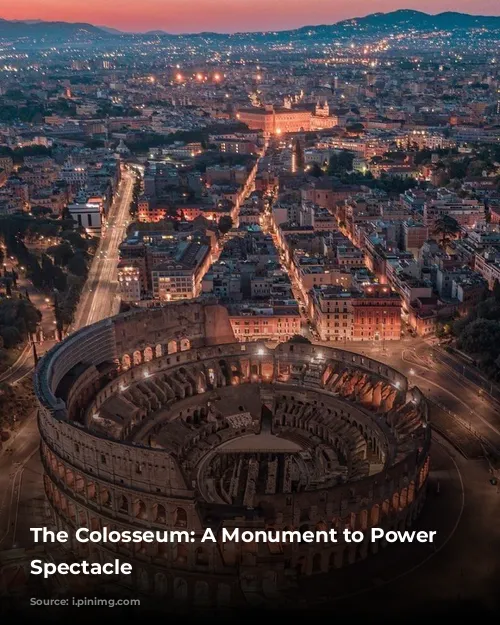The Colosseum stands as a testament to the grandeur of the Roman Empire. This massive amphitheatre, built by Emperor Vespasian and inaugurated by his son Titus in 80 A.D., was the largest and most impressive arena in the Roman world. Its sheer size and architectural prowess make it one of the most iconic landmarks in Rome and indeed, the entire world.
A Spectacle to Behold
The Colosseum’s opening ceremony was a lavish affair, lasting one hundred days and showcasing a dazzling array of spectacles. Gladiatorial combats, animal hunts, and even naumachiae – simulated sea battles – thrilled the crowds. Imagine the spectacle of real battles recreated within the arena’s flooded floor! It is no wonder that the Colosseum was renowned for its grandeur and the awe-inspiring displays it hosted.
The Origins of a Name
While the amphitheatre is often referred to as the Colosseum, its original name was the Flavian Amphitheatre, named for the Flavian dynasty that commissioned its construction. However, the name Colosseum emerged in medieval times, possibly stemming from a prophecy by Venerable Bede. Bede’s prophecy stated that Rome would stand as long as the Colosseum, suggesting a connection between the monument’s fate and the city’s destiny. It’s fascinating to consider that the name may have been inspired by the towering statue of Emperor Nero, known as the “Colossus,” which once stood nearby.
Architectural Masterpiece
The Colosseum is an architectural marvel. Constructed from travertine stone, the building’s elliptical shape maximized spectator capacity, accommodating up to 70,000 people. The structure consisted of four tiers, with each of the first three tiers boasting eighty arches adorned with magnificent statues. It’s mind-boggling to think that this immense building was erected in less than a decade.
Roman Ingenuity
The Romans were masters of arch construction, a technique that allowed them to distribute weight effectively. The Colosseum exemplifies this skill, resembling a series of aqueducts stacked on top of each other. This ingenious architectural approach enabled them to create a monument that defied the limitations of its time.
A Symbol of Power and Decay
The Colosseum has witnessed both glory and decline. Today, we see only a skeleton of its former grandeur, with three-fifths of the outer wall missing. Sadly, this monumental structure was once quarried for materials, supplying stone for the construction of other famous Roman buildings like St. Peter’s Basilica.
A Venue for the Masses
The Colosseum was not just a spectacle; it was a social space that reflected the societal hierarchies of Roman society. While entry was free for all Roman citizens, seating arrangements reflected social status. The upper tiers were reserved for the common people, while the lower tiers were for the elite, including senators, priests, and the emperor himself.
The Power of the Velarium
The Colosseum provided efficient protection from the sun thanks to its ingenious roof covering, the Velarium. This massive linen awning, suspended by ropes, winches, and wooden poles, could be manipulated by 100 sailors from the Imperial fleet, creating a truly awe-inspiring spectacle of coordinated movement.
The Gladiators’ Arena
The Colosseum’s arena was the stage for countless spectacles. The underground floors housed lifts and hoists that allowed for dramatic entrances of gladiators and animals, adding to the spectacle and surprise.
A Spectacle of Brutality and Entertainment
The events held within the Colosseum were a mix of brutal and entertaining. Gladiatorial combat, animal hunts, and public executions were all part of the entertainment landscape. The “Venationes,” featuring fights between exotic animals or men and beasts, were a particular favorite of the Roman crowds.
A Glimpse into Ancient Roman Life
The Colosseum stands as a powerful reminder of the life and culture of the ancient Romans. It represents not only their architectural prowess but also their fascination with spectacle and their acceptance of brutality. While we may find some of the events barbaric today, it is important to understand that they were a crucial part of Roman life, offering entertainment, social interaction, and a sense of community.
A Lasting Legacy
Despite the passage of time, the Colosseum continues to captivate and inspire. It is a symbol of both the grandeur and the decay of the Roman Empire, a reminder of the enduring power of history and the human capacity for both awe and brutality. As Charles Dickens aptly described it, visiting the Colosseum is like “seeing the ghost of old Rome floating over the places its people walk in.” Today, the Colosseum stands as a UNESCO World Heritage Site, attracting millions of visitors each year and reminding us of the incredible legacy of the Roman Empire.
